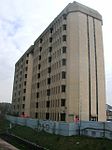Seven Stars, West Kensington
20th-century architecture in the United KingdomCommercial buildings completed in 1921Former pubs in LondonPub stubsPubs in the London Borough of Hammersmith and Fulham ... and 2 more
Use British English from August 2015West Kensington

The Seven Stars is a former Fuller's pub at 253 North End Road, Fulham, London. It was rebuilt in 1938 with a typical art deco facade, designed by John Nowell Parr, son of the famous pub architect T. H. Nowell Parr. However, there has been a pub on the site since at least the 19th century.In 2009, it was sold by Fuller's to a developer, and closed in 2010.Since 2013, it has been a student hostel, Yara Central, Kensington, owned by Yara Capital Ltd, with 24 studio rooms available to rent.
Excerpt from the Wikipedia article Seven Stars, West Kensington (License: CC BY-SA 3.0, Authors, Images).Seven Stars, West Kensington
North End Road, London West Kensington (London Borough of Hammersmith and Fulham)
Geographical coordinates (GPS) Address External links Nearby Places Show on map
Geographical coordinates (GPS)
| Latitude | Longitude |
|---|---|
| N 51.4871 ° | E -0.2031 ° |
Address
The Seven Stars
North End Road
W14 9NU London, West Kensington (London Borough of Hammersmith and Fulham)
England, United Kingdom
Open on Google Maps










